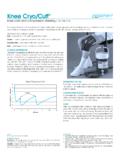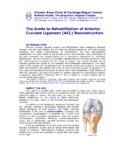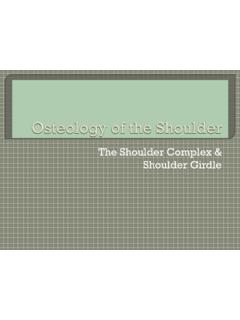Transcription of Anterior Knee Pain and Patellofemoral Problems
1 Chester Knee Clinic The Grosvenor Nuffield Hospital Wrexham Road Chester CH4 7QP Telephone 01244 680 444 Fax 01244 680 812 Anterior Knee Pain and Patellofemoral Problems What is Patellofemoral joint? The knee joint is made of two main joints: tibiofemoral and Patellofemoral . The patella (knee cap), is a mobile, flat, triangular bone within the tendon of the quadriceps muscles, which articulates with the femoral trochlea (groove at the end and on the top of the thighbone). Anterior knee pain Patients with Patellofemoral pain represent a significant challenge to the orthopaedic and rehabilitation community, despite recent advances in the understanding of almost all other knee conditions. This clinical conundrum is often aptly named The Black Hole of Orthopaedics , implying that no single explanation or therapeutic approach has fully clarified this problem yet. The primary factor differentiating this clinical problem from other knee conditions is its inherent subjectivity.
2 Anterior knee pain, or Patellofemoral pain, is pain in the front of the knee which is often made worse by sitting for prolonged periods, stair climbing or any activity which involves bending the knee. It is often aggravated by sport. The origin of Patellofemoral pain can be directly traced to supraphysiological mechanical loading and mechanical or chemical irritation of nerve endings. Studies have shown that Patellofemoral pain syndrome (PFPS) comprises up to 50% of overuse injuries. Even activities of daily living can become supraphysiologic. This syndrome seems to be caused by the damage to the under surface of the patella, or Patellofemoral articulating surfaces, often inappropriately called chondromalacia patella. What causes Patellofemoral pain? Pure patellar pain remains poorly understood. Maltracking and damaged articular cartilage seem to be the main suspects and the origin of pain. Articular cartilage lesions themselves are asymptomatic, although the alteration of normal protective compressive stiffness and load-bearing properties of thinned-out or damaged articular surface remains a potential source of pain.
3 Contributing factors Several anatomical factors like genu valgum (knock knees), abnormal twisting of the femur (femoral torsion), and flat (pronated) feet contribute to the onset of Anterior knee pain. When the patella is not centred in the groove of the femur, there is an imbalance that results in increased pressures between articulating surfaces and subsequent accelerated wear and tear (patella malalignment). Most clinicians subscribe to the concept of patellar malalignment as a source of pain. Abnormal pressure on the patella may result in Patellofemoral knee pain. If you are very active and are involved in sporting activities the pressure may be normally placed through the patella but in excessive amounts, an example would be jogging, where as much as seven times ones body weight may be transmitted through the knee. Overuse, especially the pounding shocks absorbed during jogging and downhill running, previous knee injuries like a direct blow to the front of the knee, and obesity are all significant contributing factors.
4 The aetiology* The aetiology of Patellofemoral pain syndrome is multifactorial. Causes include overuse and overload, biomechanical Problems and muscular dysfunction. Overuse and overload: because bending the knee increases the pressure between the patella and its various points of contact with the femur, Patellofemoral pain syndrome is often classified as an overuse injury. However, a more appropriate term may be "overload," because the syndrome can also affect inactive patients. Repeated weight-bearing impact may be a contributing factor, particularly in runners. Steps, hills and uneven surfaces tend to exacerbate Patellofemoral pain. Once the syndrome has developed, even prolonged sitting can be painful because of the extra pressure between the patella and the femur during knee flexion. Biomechanical Problems and muscular dysfunction: no single biomechanical factor has been identified as a primary cause of Patellofemoral pain, although many have been studied: Pes planus (pronation): the terms "flat feet" and "foot pronation" are often used interchangeably.
5 Technically speaking, foot pronation is a combination of eversion, dorsiflexion and abduction of the foot. This condition often occurs in patients who lack a supportive medial arch. Hyperpronation with a secondary increase in transverse plane motion of the tibia often leads to eccentric loading of the patella. This includes over use of the vastus lateralis and under use of the VMO. Foot pronation causes a compensatory internal rotation of the tibia or femur (femoral anteversion) that upsets the Patellofemoral mechanism. This is the premise behind using arch supports or custom orthotics in patients with Patellofemoral pain. Pes cavus (high-arched foot, supination): compared with a normal foot, a high-arched foot provides less cushioning for the leg when it strikes the ground. This places more stress on the Patellofemoral mechanism, particularly when a person is running. Proper footwear, such as running shoes with extra cushioning and an arch support, can be helpful.
6 Q Angle: although some investigators believe that a "large" Q angle (an angle between the longitudinal axis of femoral and tibial shafts) is a predisposing factor for Patellofemoral pain, others question this concept. One study found similar Q angles in symptomatic and non-symptomatic patients. Furthermore, "normal" Q angles vary from 10 to 22 degrees depending on the study, and measurements of the Q angle in the same patient vary from clinician to clinician. Muscular causes: the potential muscular causes of Patellofemoral pain can be divided into "weakness" and "inflexibility" categories. Weakness of the quadriceps muscles is the most often cited area of concern. Treatment of Patellofemoral pain* Relative rest: initially, knee activity should be reduced, at least relatively, because the theory that Patellofemoral pain is an overuse and overload syndrome has merit. A relatively inactive patient can benefit from simply straightening the leg or walking periodically as needed.
7 If the patient is a runner or engages in impact activity and insists on continuing some rigorous activity, swimming or another nonimpact aerobic activity is a reasonable recommendation. For example, the so-called "elliptical" nonimpact exercise machines at gyms have become quite popular for providing nonimpact aerobic activity. 2 Ice and anti-inflammatory drugs: ice is the safest anti-inflammatory "medication," but its successful use requires discipline. Applying ice for 10 to 20 minutes after activity is reasonable. A common complaint is the inconvenience of holding an ice bag on the knee, but a simple elastic wrap or a towel solves this problem. A frozen gel pack, crushed ice in a plastic bag or a bag of frozen peas also work well. Alternatively, special mechanical cooling devices may be useful to people with chronic Patellofemoral pain (go to for more information). Patients with Patellofemoral pain syndrome have not been conclusively shown to benefit from anti-inflammatory drugs (NSAIDs).
8 Although the same can be said about many other treatments for Patellofemoral pain, the drawback of NSAIDs is that their potential side effects may be more significant than any adverse effects of ice application or exercises. Knee sleeves and braces: the use of knee sleeves and braces in patients with Patellofemoral pain remains controversial. A simple elastic knee sleeve with a patellar cut-out may provide some benefit, although this remains unproved. Typically, knee braces have a C-shaped lateral buttress that keeps the patella from moving too far laterally. However, the Patellofemoral and extensor mechanisms are complex and the patella moves in several planes. Knee braces are probably best reserved for use in patients with clinically obvious lateral subluxation. The use of a knee brace or sleeve should not be considered a substitute for exercises. For more information on patella braces visit: Footwear, arch supports and custom orthotics: walking and athletic shoes have improved significantly in the past decade.
9 Generally speaking, the quality and age of footwear are more important than the brand name - a new, quality shoe may help to alleviate Anterior knee pain. Most runners change their shoes every 300 to 500 miles. Arch supports or custom orthotics can be helpful in patients with a wide variety of lower extremity complaints, including Patellofemoral pain. Although the reasons are not entirely clear, an arch support may improve lower extremity biomechanics by preventing overpronation in pes planus and by providing a broader base of support for the normal or pes cavus foot. Over-the-counter arch supports are a reasonable and relatively inexpensive initial suggestion. Custom orthotics may be worth a try if an over-the-counter insert is not helpful, although they are more expensive ( ). Exercises continue to be the mainstay of treatment for Patellofemoral pain syndrome. Historically this has involved strengthening the quadriceps muscle, in particular the vastus medialis obliquus muscle (VMO), but disagreement about the best technique for strengthening the VMO muscle continues.
10 Currently a more global approach to optimizing function of the lower-extremity kinematic chain is advocated. This can include: optimizing the strength of the pelvifemoral musculature to help control limb alignment and rotation, optimizing the balance between quadriceps and hamstring muscle strength and firing sequence, optimizing the balance between the individual components of the quadriceps muscle bellies, in particular the medial and lateral dynamic stabilizers of the patella, and improving proprioception. Although these approaches have been shown to be beneficial in alleviating Patellofemoral pain syndrome, the relationship between neuromotor control of the knee musculature and the onset or recurrence of symptoms continues to be poorly understood. Dedicated patients can often manage Patellofemoral rehabilitation on their own, with 20 minutes per day being a reasonable expectation. Flexibility deficits in the hip external rotators, hamstrings, quadriceps, and gastroconemius-soleus muscle group may contribute to abnormal Patellofemoral biomechanics.





